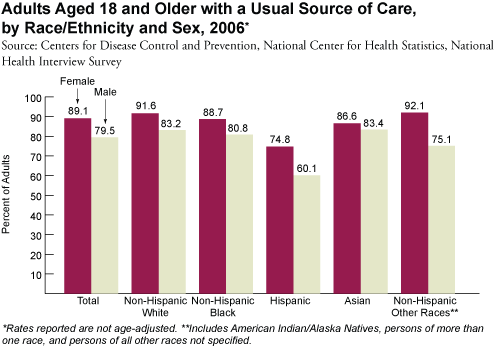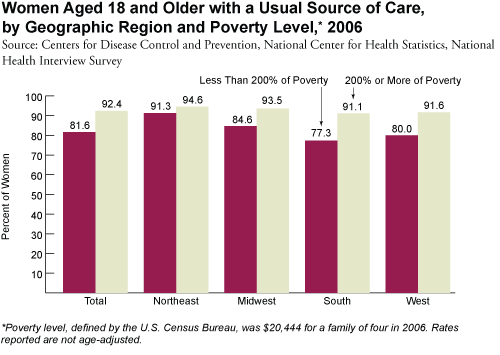Usual Source of Care
Women who have a usual source of care (a place they usually go when they are sick) are more likely to receive preventive care,1 to have access to care (as indicated by use of a physician or emergency department, or not delaying seeking care when needed),2 to receive continuous care, and to have lower rates of hospitalization and lower health care costs.3 In 2006, 89.1 percent of women reported having a usual source of care. Women of all racial and ethnic groups were more likely than men to have a usual source of care. Non-Hispanic women of other races and non-Hispanic White women were most likely to report a usual source of care (92.1 and 91.6 percent, respectively). Among women, Hispanics were least likely to report a usual source of care (74.8 percent).
In 2006, the percentage of women with a usual source of care varied by geographic region and poverty level. Among women with household incomes of 200 percent or more of poverty, there was little variation in having a usual source of care by geographic region. Among women with lower incomes, however, having a usual source of care varied significantly by geographic region. Women with incomes of less than 200 percent of poverty in the South and West were least likely to have a usual source of care (77.3 and 80.0 percent, respectively), while low-income women in the Northeast were most likely to have a usual source of care (91.3 percent).
1 DeVoe JE, Fryer GE, Phillips R, Green LA. Receipt of Preventive Care Among Adults: Insurance Status and Usual Source of Care. AJPH. 2003;93(5):786-791.↑
2 Fryer GE, Dovey SM, Green LA. The importance of having a usual source of health care. Am Fam Physician. 2000;62:477.↑
3 Weiss LJ, Blustein J. Faithful patients: the effect of long-term physician-patient relationships on the cost and use of health care by older Americans. AJPH 1996;86(12):1742-7.
↑


